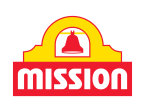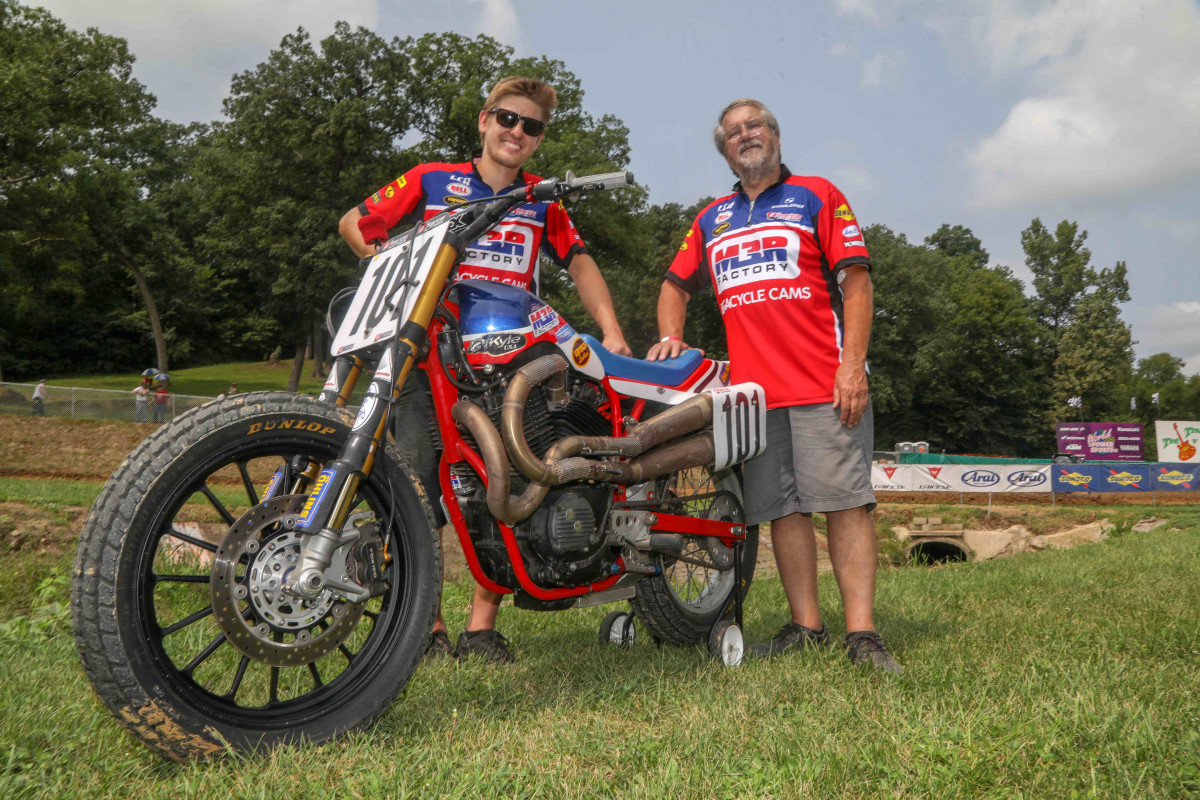
Soul Survivor: Mac and Mark McGrew’s Honda RS750
In a paddock-full of Indian FTR750s, Kawasaki 650s, Yamaha MT-07s, Harley-Davidson XG750Rs, old-school XR750s, Ducati 821s or big-bore KTMs, it is a true anomaly – an ’80s/’90s-spec blast-from-the-past motorcycle that authored a brief but significant chapter in the history of professional twin-cylinder dirt track racing in America.
It is the legendary Honda RS750, and there is exactly one team campaigning the model in American Flat Track competition: Mac McGrew and his father Mark. The story of the RS750 and Honda’s involvement in American dirt track racing is long, involved and often told, but boiled down it’s essentially this:
Honda Motor Company, which in many ways launched and fueled – and capitalized on – motorcycling’s explosive growth and substantial heft in the decades of the ’60s, ’70s and ’80s (and beyond), had a penchant for dominating every area it cared compete in, whether sales- or competition-related. When Honda entered a displacement category or styling genre or racing discipline, it entered to win – and nearly always did. The company’s visceral and seemingly superhuman engineering prowess, urged on by the driving spirit of founder Sochiro Honda and fueled by more cubic dollars than any other manufacturer was usually willing to part with, was more often than not an unbeatable combination, which every manufacturer and race team in the world soon discovered.
By the early 1980s, Honda was either dominating – or preparing to dominate – everything it touched, from new-bike sales, to AMA motocross and Supercross, and to Grand Prix and American roadracing, and much more. One area in which it was a notable non-player was professional dirt track racing, long a bastion of Harley-Davidson Motor Company, a company at the time struggling mightily and near death both financially and engineering-wise. In fact, you could say that Milwaukee’s only area of success at the time was dirt track – aided by its stalwart and omnipresent XR750 racer, which filled the paddock and won nearly every race thanks to its balanced combination of handling and tractable power.
Honda, being Honda, wanted in, wanted to win at dirt track, and soon got busy with dynos and frame jigs and cutting torches and engineering prowess and money … lots of money. This was not a Japanese-side effort, per se; the vast majority of the work and brainpower for the dirt track effort came from a few dedicated souls burrowed in American Honda’s Gardena, California skunk works along with a host of dirt track experts, machinists and fabricators from around the country who knew a thing or two about turning left and doing it rapidly.
Honda’s first efforts included an XR500-based single and, later, a twin-cylinder racer – prototyped originally by Jerry Griffith – that was powered by a Frankensteined and de-shafted CX500 engine turned 90 degrees in the frame. Ridden by Freddie Spencer and others in ’81 and ’82, the NS750 won only one race (in ’82), but set the stage for the clean-sheet RS750, which debuted in ’83 (winning a race) and then dominated for several years after, winning the Grand National Championship under Ricky Graham and Bubba Shobert a total of five times in the ’80s and early ’90s.
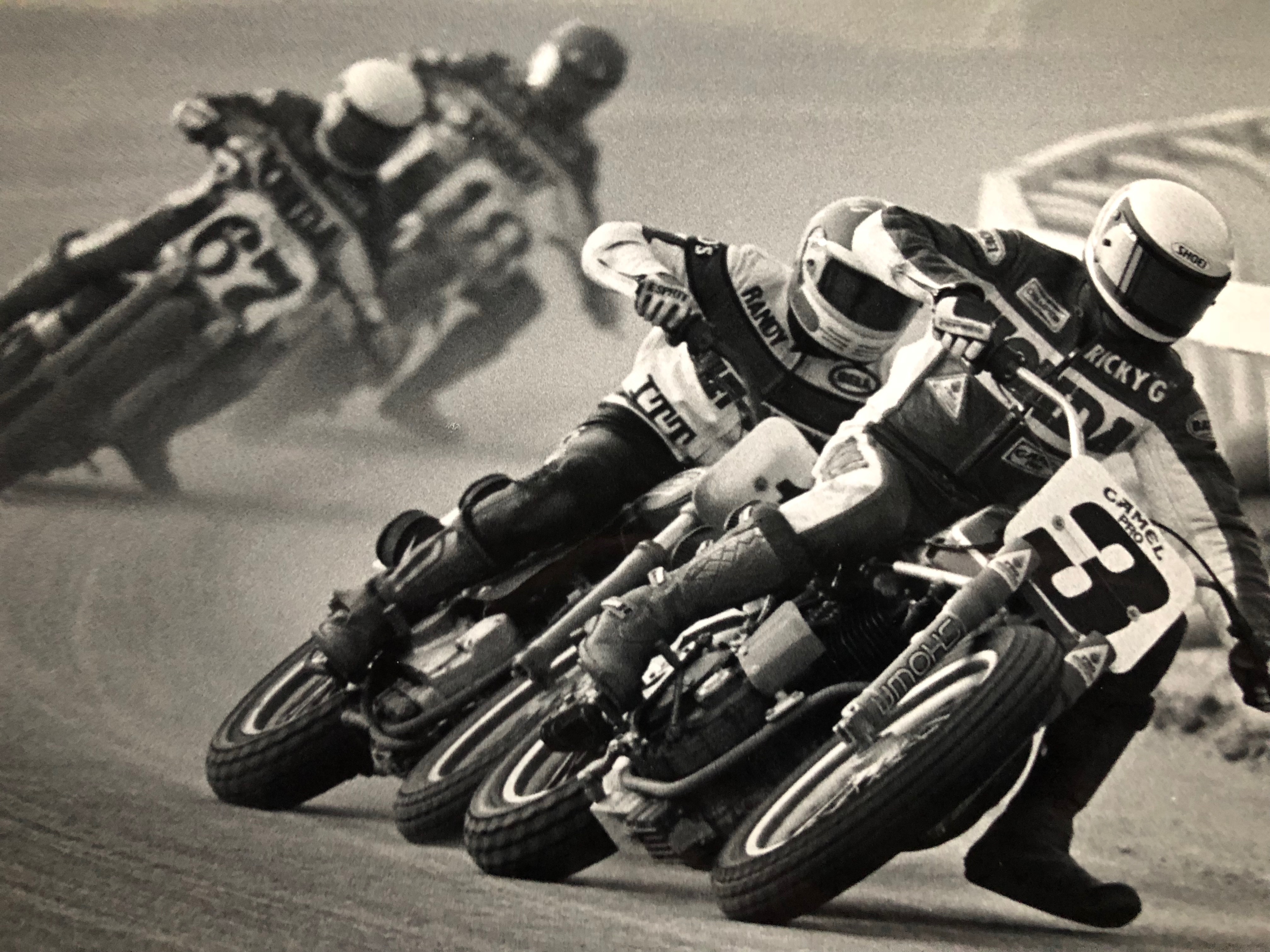
The 1980s were a true Golden Era of professional dirt track racing, with Harley-Davidson XR750s going bar-to-bar with Honda RS750s every race weekend. Here, Ricky Graham (3) holds off Randy Goss, Bubba Shobert (67) and Terry Poovey (18) at the Hawthorne Mile in Cicero, IL on August 5, 1984. Graham went on to win the GNC title over Shobert that year by a single point.
With an engine based on the narrow-angle (45-degree) V-twin from the 1983-spec Euro-only XLV750R (which, sadly, never made it to American shores), the RS750 featured a fairly conventional steel-tube frame, an advanced-for-the-time Pro-Link single shock rear suspension system – and an engine that did the XR750 three better. It made a few more horsepower. It revved higher but didn’t suffer the XR’s high-rpm mechanical issues thanks largely to plain bearings (vs. rollers), overhead camshafts (vs. pushrods), and four-valve (vs. two-valve) cylinder heads. And it had a good flat track torque curve, meaning it made power over a wide RPM range and transferred it to the ground efficiently, controllably and effectively from mid-corner on – much like the XR. It even had the same bore and stroke numbers as the XR.
Eventually, of course, the playing field was ‘leveled’ via restrictor plates and intake limits, which seemed to hurt the Honda a bit more than the Harley. But it didn’t much matter. By ’88, Honda had had enough American motorcycle industry and government politics (recall the over-700cc tariffs) and was happy to shutter its factory dirt track team – and quietly look for the next two- or four-wheeled frontier to conquer.
A few teams continued campaigning the RS, as parts were still available, most notably Team Undo Racing’s Ricky Graham and Johnny Goad, who had a promising effort in ’92 (especially after Graham was fired by Skip Eaken and subsequently quit drinking) and went on to win the Grand National Championship in ’93 in historic and dramatic fashion. Graham won an amazing 12 races in ’93, six of them in succession, setting records that weren’t assailable even by Jared Mees’s astounding 2018 season. They may never be broken. Graham was also AMA Athlete of the Year in ’93. “I felt better on that Honda than I did in my championship years,” Graham told this editor between the ’92 and ’93 seasons. “The RS is expensive to maintain and not quite as fast as the works Harleys of [Scott] Parker and [Chris] Carr, but it’s still better than a non-factory XR.”
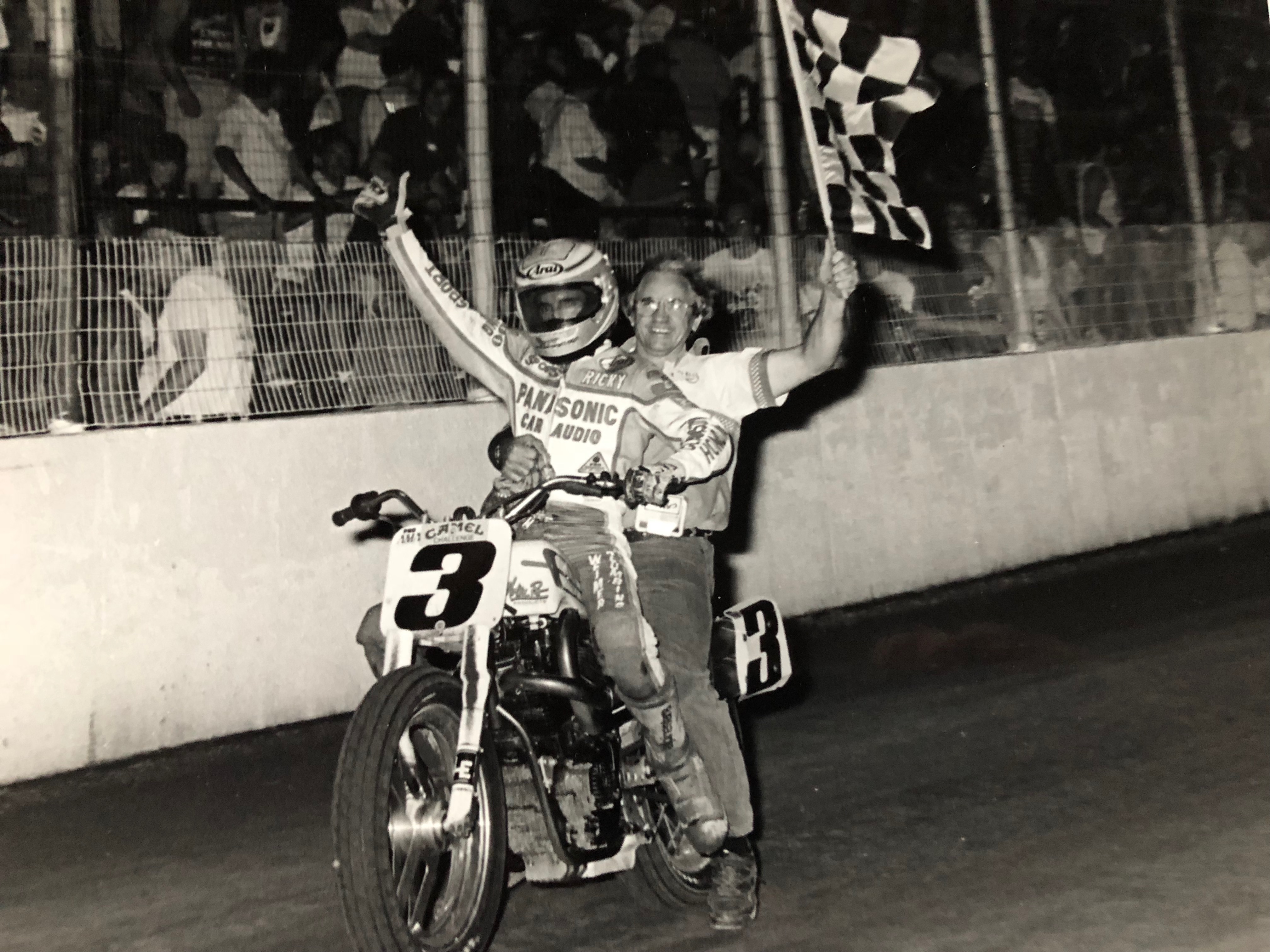
Ricky Graham celebrating with crew chief Johnny Goad in 1993, the year RG won 12 Mains - six of them in a row! - on his way to that year's Grand National Championship on the Team UNDO Racing/Panasonic/Motion Pro Honda RS750.
Over time, of course, RS parts supplies ran low, prices for those parts increased, and technical expertise dwindled – and soon the RS ceased to be a factor at all, which meant development – what there was of it, anyway – stopped cold. Development of the XR750 continued unabated, by the factory and the large contingent of teams running them, and the XR reestablished itself as pretty much the only game in town.
All of which brings us back to the McGrews, Mac and his dad Mark, who in 2012 were considering getting into the professional flat track scene. Mark is a long time Honda guy, having worked for American Honda and having been involved in quite a bit of vintage roadracing over the last few decades, so when an RS came up for sale, their plans took a hard turn to the left.
“My father's roots with Honda have been a heavy influence on why we race our RS750s,” the younger McGrew said when we asked about the family’s connection to the RS and why they race them. “Whether it’s been working on Hondas or working for American Honda, it ultimately meant growing up with Hondas. If it had two wheels it was going to be a red bike. I still remember racing my first motorcycle, a 1983 Z50, against a lineup of Cobra and KTM 2-stroke 50s due to the fact ours had a chain. There wasn't a chance in hell that fat-tire Z50 would stand a chance to any 2-stroke counterpart, other than maybe a PW50 or a JR50, but that’s what I had and that’s what we got to race. After that we advanced to the 60-65cc class, so we ran an old (1984) Honda CR60! I couldn't really complain too much, as it was a night-and-day difference from the 4-stroke Z50, but still a little ways from the liquid-cooled Kawasakis. So to say the least, that’s been a huge influence in our efforts with the RS750.
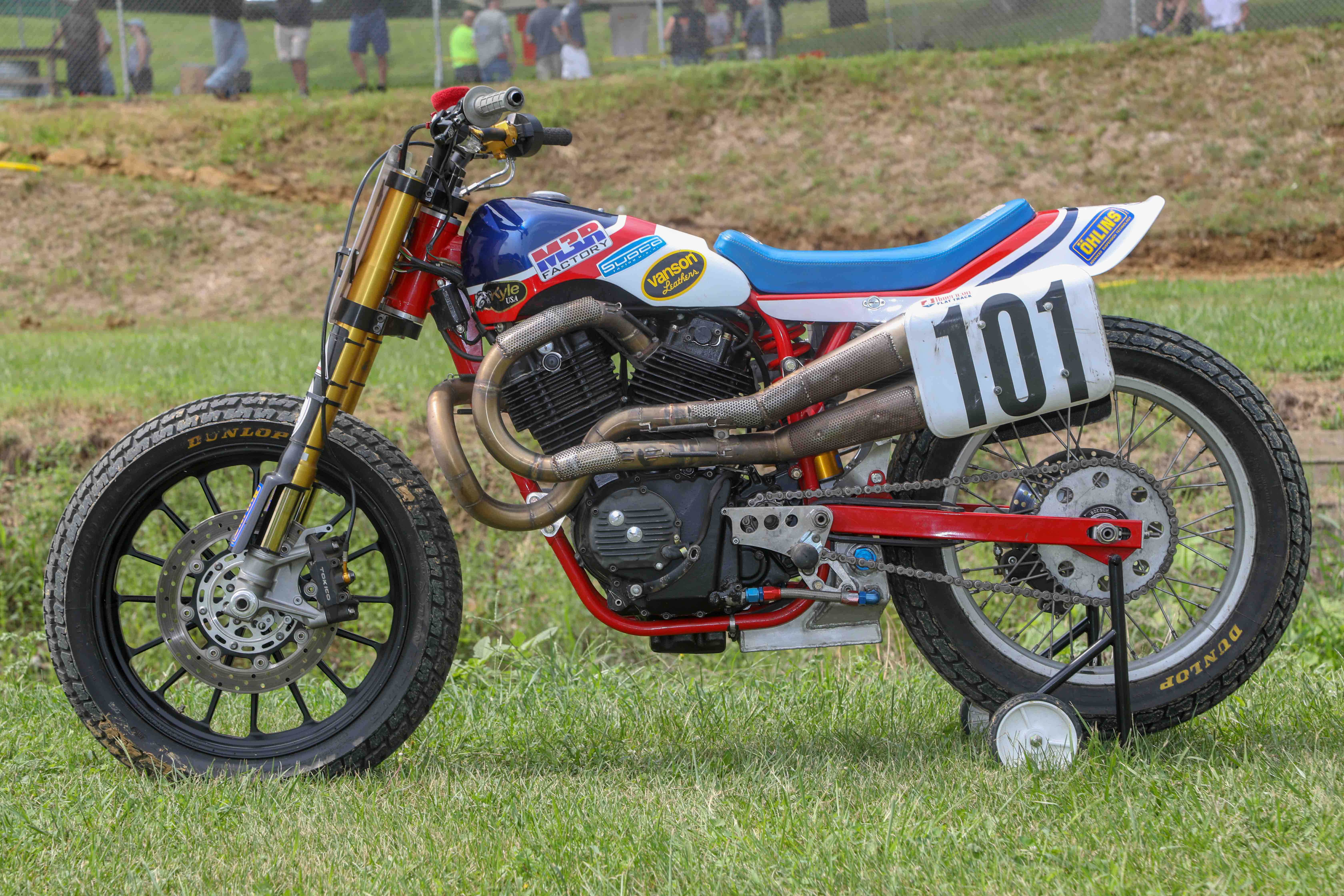
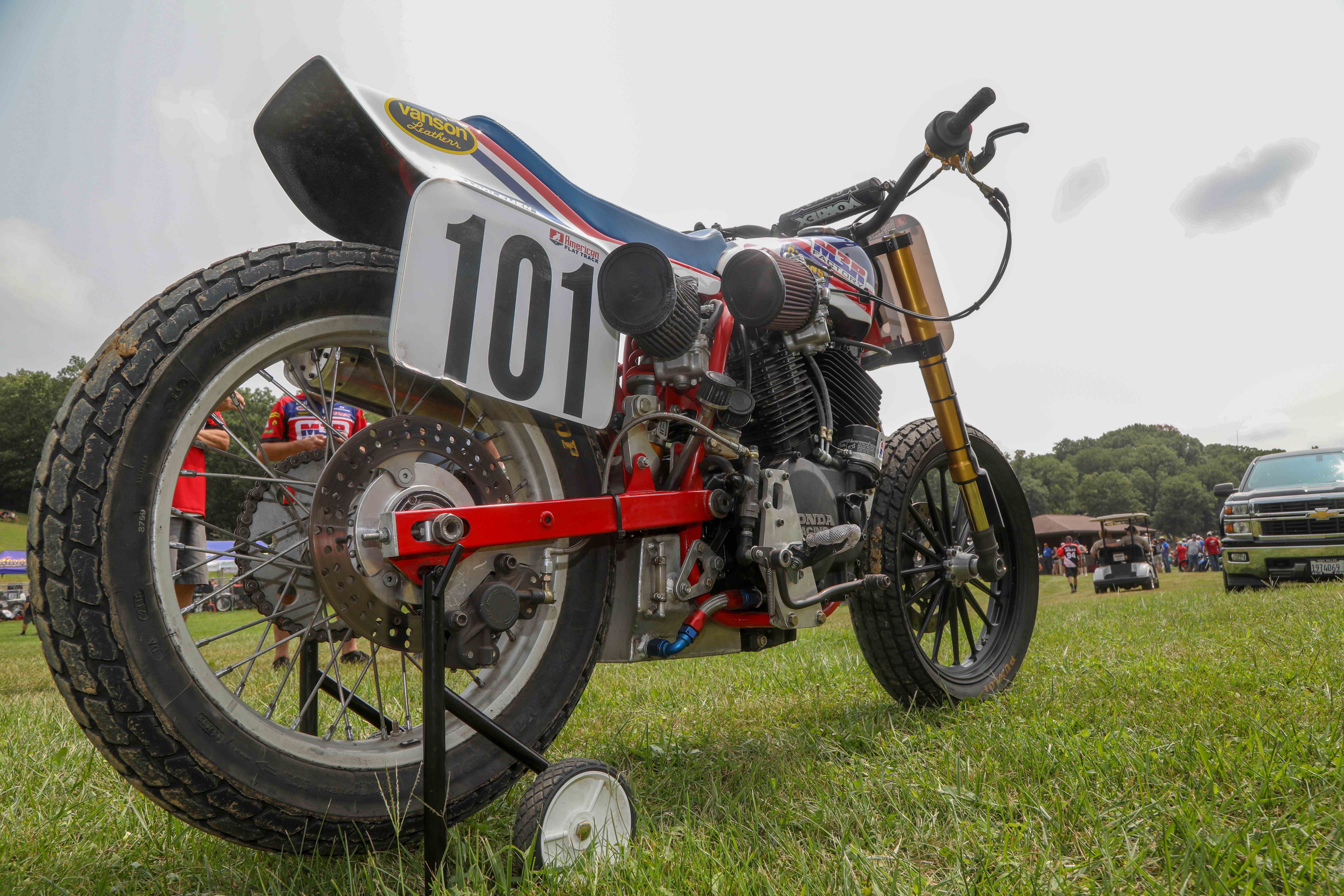
This is the McGrew's TT-spec RS750, photographed at this year's Peoria TT. It was built for the 2017 season, and like their Mile and Half-Mile bike, it uses a C&J frame - as did the majority of bikes from the 1980s, including the factory machines of Shobert, Graham and Chandler. Photos: Scott Hunter/AFT.
“Anyway,” McGrew added, “when the Pro Twins/Basic Twins class originally was announced at the end of 2012, we were considering a Kawasaki platform to get started on, but we still had the wild idea in the back of our heads about putting together an RS to compete on. It just so happened that in the winter of 2012/2013 a mostly-complete RS came up for sale. The rest is history.”
Honda built fewer than a hundred complete RS engines, and while it sold a lot of parts over the years, used RS750s are rare pieces. The McGrew’s first RS came from the usual place – eBay. “We found the first one there, the Mile and Half-Mile machine we run,” says McGrew, “and it was not pretty [see photos]. It apparently had some history as a Team Corbin machine. It was listed as, simply, ‘CB750 race bike,’, which was a little strange. In 2017, with the jump to the AFT Twins class and rules, it became apparent we were going to need to build a second bike for the TT courses. We started with a bare frame we had built by Jeff Cole of C&J Racing Frames in January of 2017, and two months later we debuted the bike – which was built from scratch – at the DAYTONA TT that March. We continue to develop both bikes.”
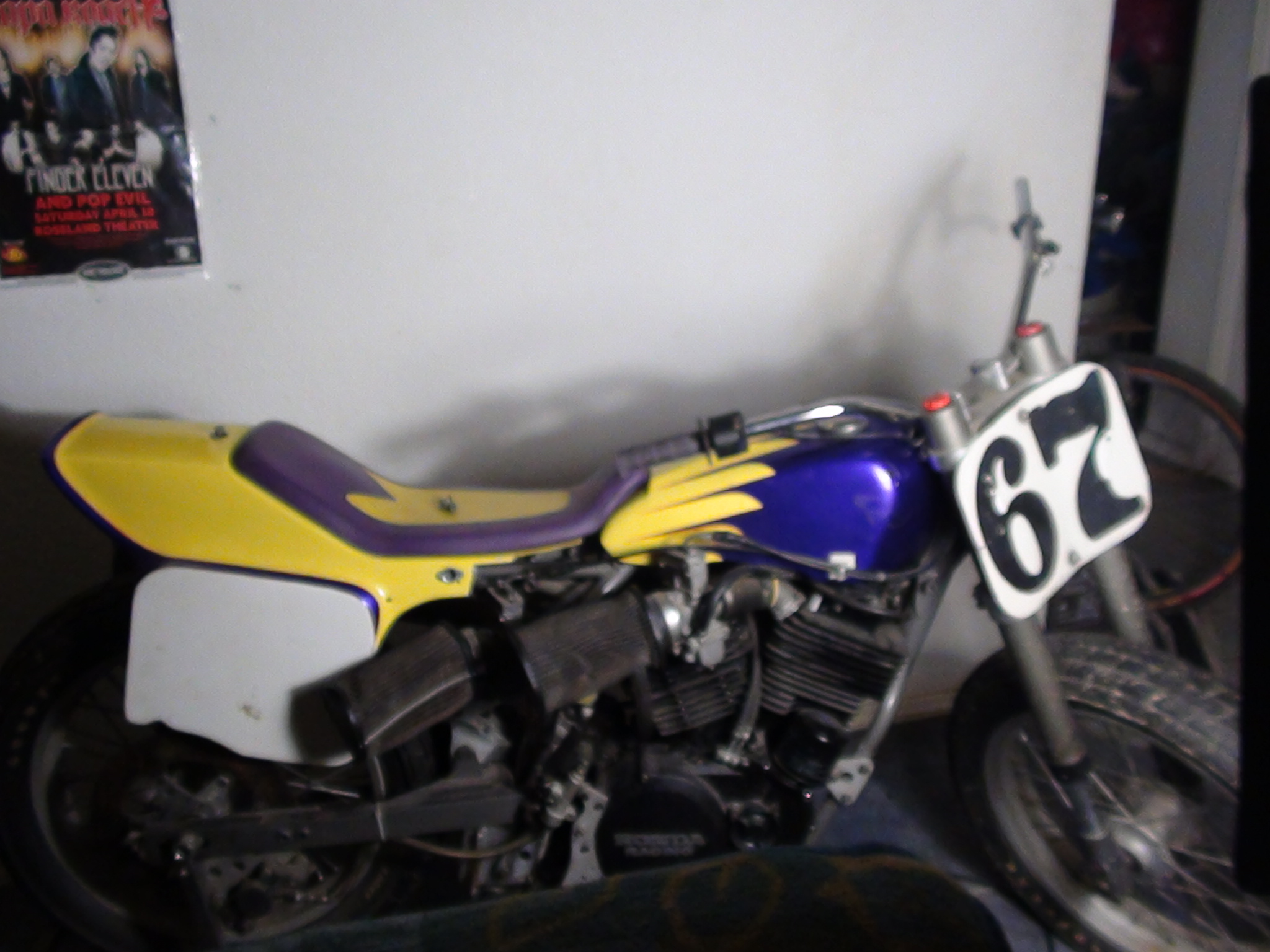
Listed on eBay as a "Honda CB750 race bike," the McGrew's first RS, which they acquired and built back in 2012/'13, was in pathetic shape...
If complete bikes are rare, parts for them are even rarer these days. Years ago, American Honda fire-saled tons of out-of-date racing parts, and enterprising (or just needy) roadracing, motocross and dirt track teams, riders and collectors gobbled them up. Such was the case with RS parts. The McGrews missed that fire sale, but eventually found a parts source. “We bought all the RS parts George Garvis – out of Des Moines, Iowa – had when he closed his doors a few years ago,” Mac says. “George raced RS750s from ’85 until the mid-’90s with Rich King and Ronnie Jones. What we don’t have or can’t get we typically make ourselves.”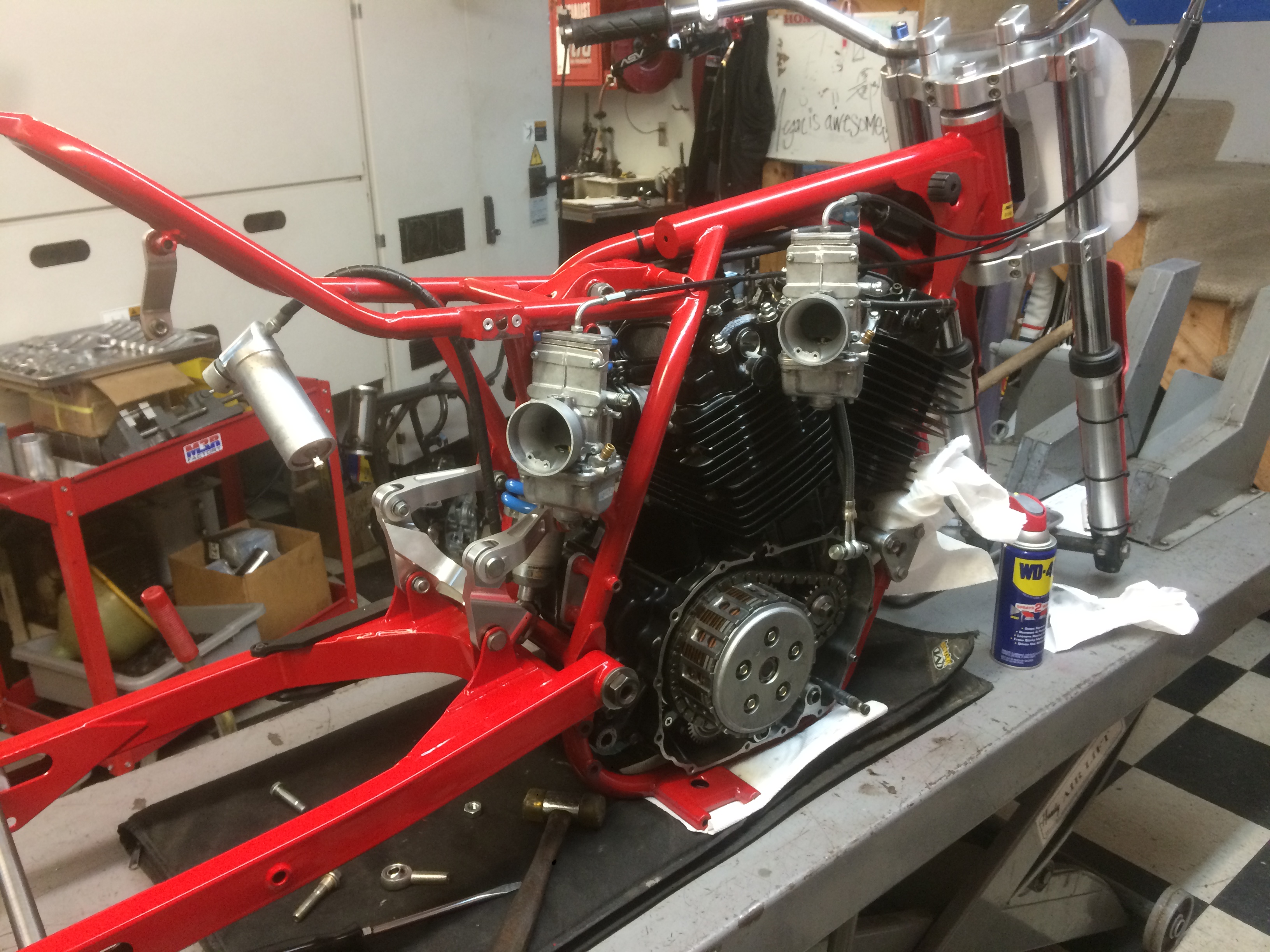
...but over time, and with loads of elbow grease, parts and money, began to take shape on the M3R Racing workbench.
Campaigning an RS750 isn’t all that much different than competing on an XR750, as the bikes are reasonably similar, especially compared to today’s liquid-cooled, fuel-injected bikes. McGrew says the air-cooled and carbureted RS makes rear-wheel horsepower numbers in the mid-90s.
“We run ’em per Team Honda specs,” McGrew says. “Cams, timing, carb settings, valve sizes circa 1983-1988. Basically, our Mile/Half-Mile machine is same engine spec (but restricted to 38mm carbs and quieter exhaust) as the factory RSs that Ricky, Doug Chandler and Bubba rode. My dad does all the engine building and wrenching on the ground, and I do whatever he forgets to do. [Laughs] I also do all the welding, fabrication and machining (manual/CNC). We invested many hours recreating parts for our original machine, and even more building our TT bike from scratch. We had a good amount of engine parts to build that second RS, but all of the auxiliary chassis parts had to be made from scratch. We added Roland Sands alloy wheels, as the required Dunlop tires are totally different from those used by Team Honda in ’83-’89. My dad worked with Hank Scott on new and more modern slipper-design pistons for our engines. We are also running upside-down Ohlins front suspension along with a more modern Ohlins rear shock.
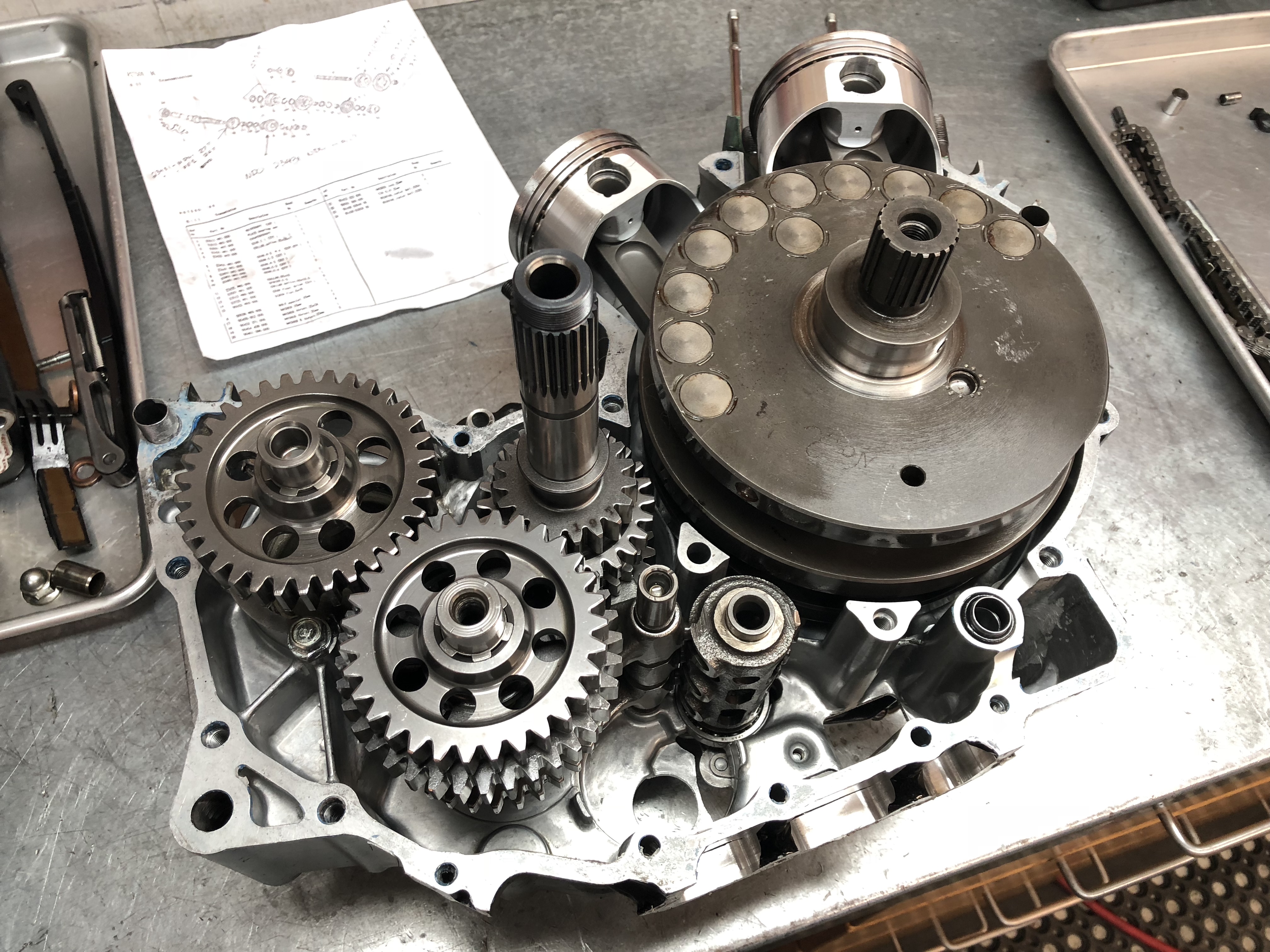
Featuring bore and stroke numbers identical to those of the XR750's, and the same 45-degree cylinder angle, the RS750 engine was born to be a dirt track engine - even though it came originally from a Euro-only Paris/Dakar production bike. Word has it that when Gene Romero, Honda's dirt track team manager in the early 1980s, saw this engine on a bench during a trip to Japan, he pointed and said this: "That's it. We need that."
“The RS is heavier by 15 pounds than most top-level machines,” McGrew added, “but it’s still a pretty competitive platform today due to the power delivery and handling. It’s just a really balanced package; there’s not just one thing that makes RS competitive. Just ask anyone who’s has ridden or raced one … they’ll tell you the same thing. Probably the biggest downfall to racing the RS is the rarity of the machine itself, and the extreme scarcity of parts to run it. As a racer, that pressure is always there every time the tires hit the track.”
For 2019, the McGrews plan to keep on keepin’ on with their unique, historical and inspiring effort. “We’re trying to make at least 9 or 10 AFT Nationals,” McGrew says, “plus some Hooligan events in Milwaukee and St. Paul, and some other events of this type where Experts can compete. Having just acquired two RS500/600 singles, in Knight and Woods frames, we’ll try just about any organization or track that will let us race.
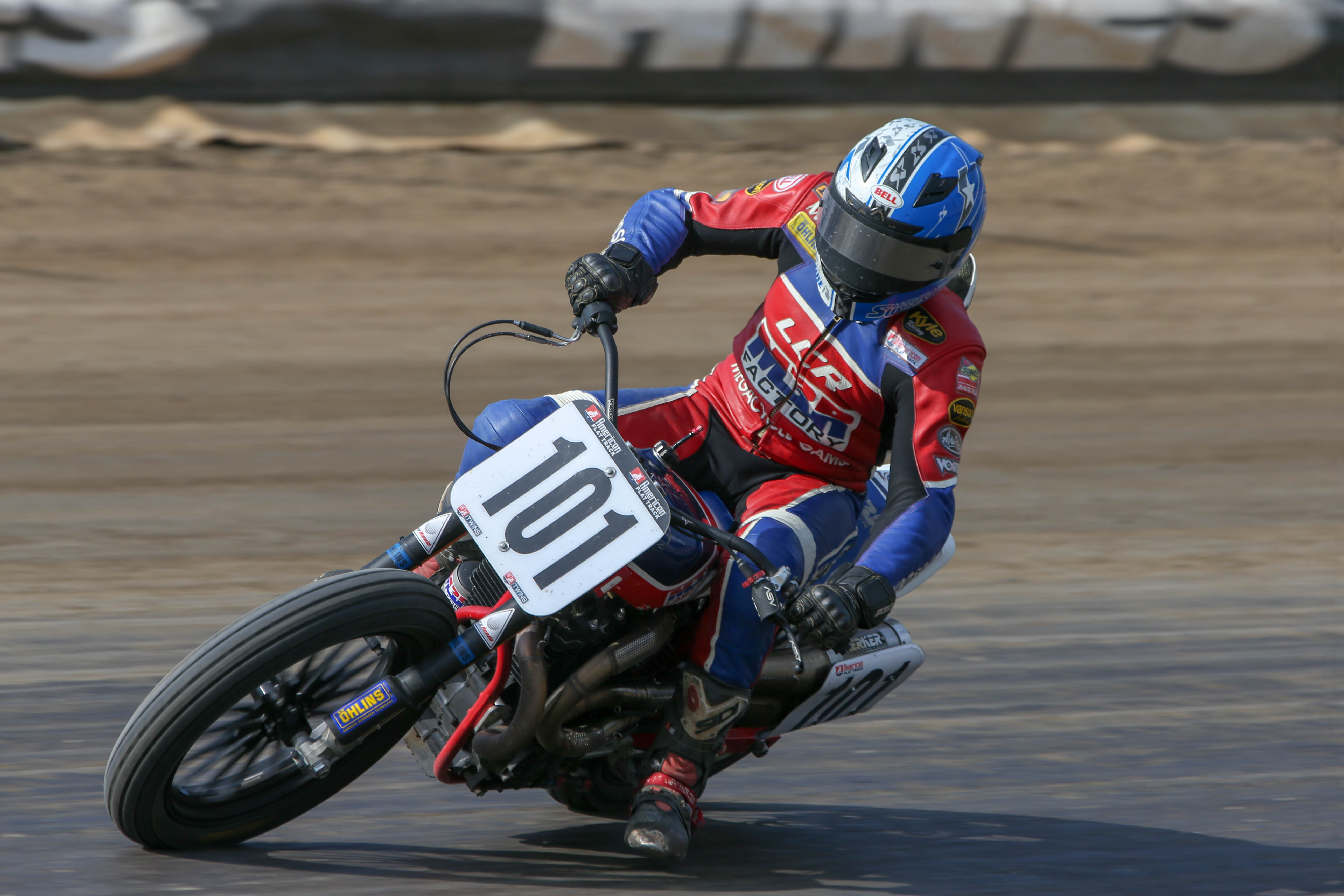
Mac McGrew on the RS750 at this year's Black Hills Half-Mile in Rapid City, SD. He didn't make the Main, but wasn't far off the pace. Photo: Scott Hunter/AFT.
“Our primary goal is to make an AFT Main this coming season,” says McGrew, “but there are new obstacles we need to plan for and deal with – the reduced Main Event field, from 18 to 16, and the elimination of Heats at events with fewer than 26 racers. Finding the financing to allow us to attend more events than we have travelled to the past four years is also something we have work on, but having said that, we are going to give it our best effort. We have a new RV with a large trailer with better at-the-track presentation. We’re working more closely with our Ohlins engineer Jon Cornwell on tires, chassis set up and riding input. And, hopefully finding more sponsorship funding to help us travel to more AFT events from our Minnesota base.”
Boil it all down and it’s pretty clear it’s not about podiums and trophies and champagne for these guys. Like any racer or team, they’re all about competing for a spot on the grid and making the cut … but in their case on a machine that holds a respected and honored place in both motorcycling and dirt track history – much as Harley-Davidson’s XR750 does. Theirs is a more emotional connection with the motorcycles they compete on, and it’s a connection that pays dividends worth more than those paid by guillotine throttle bodies and liquid-cooled cylinder heads.
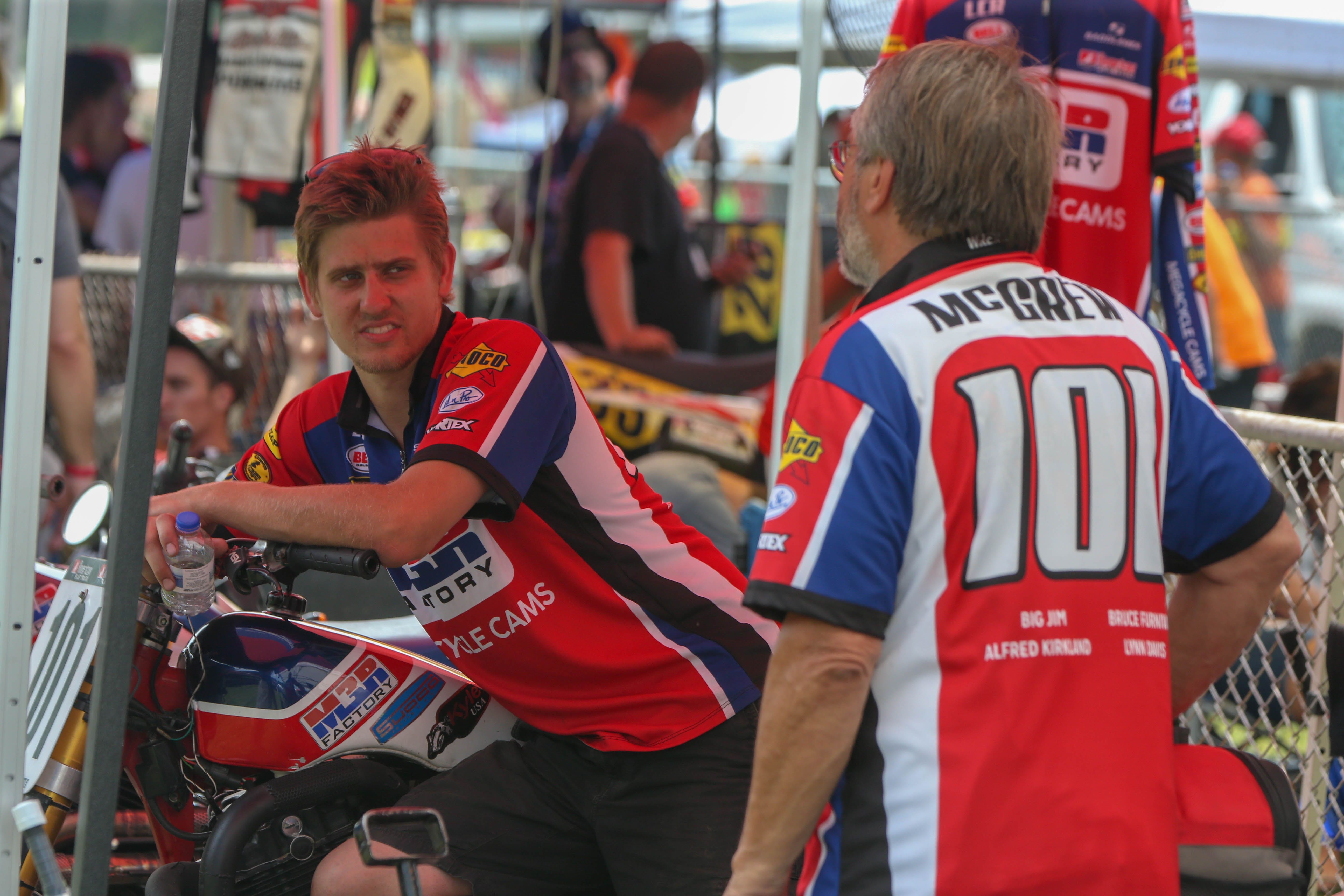
Mac and Mark McGrew at Peoria earlier this year. The duo plans to make at least 10 AFT events in 2019. Photo: Scott Hunter/AFT.
So this coming season, come say hello to the McGrews if you happen to pass by their paddock spot early in the day or during the Fan Walk, and check out their slightly-gray-at-the-temples Hondas. The ’80s Team Honda paint jobs on each are a trip back in time, for sure, and they still run and sound pretty darn good, too.
The McGrews are sponsored by the following entities: KPMI, Sudco, Vanson Leathers, American Honda Pro Chemicals/Oils (Mike Spencer) Furnavel Asscociates, Motion Pro, Ohlins, Dan Kyle Racing, Lynn Davis, Alfred Kirkland, Big Jim, Saddleman Seats.








